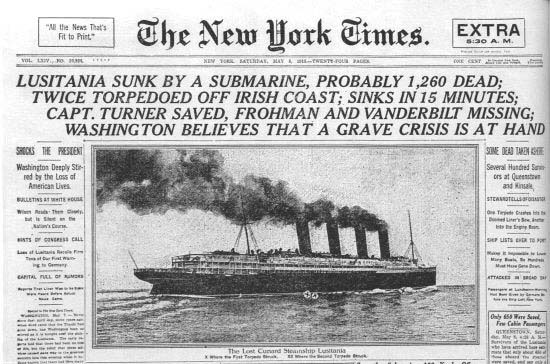Luxury Ocean Liner Sinks in Minutes; More Than a Thousand Feared Dead.
Many Americans Killed; Wilson Ponders Response.
Special to The Great War Project
(5-7 May) On May 7th precisely a century ago, at 2:10 in the afternoon off the southeast coast of Ireland, the British ocean liner Lusitania is hit by a torpedo launched from the German submarine designated U-20.
In eighteen minutes, it is gone.
The death toll is shocking. “Of the 1,959 people on board, the total of deaths was 1,198,” Erik Larson reports in his book Dead Wake. “Of thirty-three infants aboard, only six survived. Over six-hundred passengers were never found. Among the dead were 123 Americans.”
These are not the first Americans to die in Germany’s submarine war against Allied and neutral shipping. But….
…the number of Americans who perish is far larger in number than any submarine attack so far in the war.
The Lusitania’s Captain, William Turner, is warned six times on May 6th and May 7th that there are submarines hunting in the waters southeast of Ireland. On the evening of May 6th, a wireless message from the British Admiralty reads: ‘Submarines active off south coast of Ireland.’
The sixth warning from the Admiralty comes at 11:52 on the morning of May 7th.
Captain Turner expects British warships to arrive at this point to protect the enormous luxury ocean liner as it nears the British Isles, but none materializes.
The German submarine U-20 is under the command of Capt. Walther Schwieger. On this particular run, U-20 already sinks two smaller British merchant ships without warning. He has only three torpedoes remaining.
In these particular circumstances at this specific point in the ship’s journey, the British Admiralty has issued specific guidelines for civilian ships in these sea lanes.
First instruction: ‘Avoid headlands,’ the shallower waters closer to the coast, ‘near which submarines routinely lurked and found their best hunting.’
According to historian Martin Gilbert, the instructions also stressed: ‘Steer a mid-channel course.’ At a mere twelve miles off the Irish coast, the Lusitannia is far from mid-channel.
“The guidelines were to operate at full speed,” writes Gilbert. The ocean liner is far faster than the submarine, but “Turner dropped his speed. The guidelines were to steer a zigzag course. Turner was steaming on a straight course.”
It is a clear morning on this particular day, and the sea is calm. Captain Schwieger rises to periscope depth. Much to his surprise, he sees a huge ocean liner within range with four funnels belching black smoke. He knows instantly the ship is the Lusitania. One torpedo is enough to sink the huge ship.
Writes Gilbert,..
“In Britain the sinking of the Lusitania was, for the rest of the war, a powerful symbol of the conflict between right and wrong,…
the Kaiser being portrayed as the real murderer of Captain Schwieger’s victims. Anti-German riots take place as far afield as Victoria, British Columbia, and Johannesburg.”
As Germany sees it, the Lusitania is an enemy ship and legitimate target, writes historian Alexander Watson. “It was certainly carrying a cargo of small-arms and possibly also high explosives.” And Germany has warned the world it intends to attack any and all ships, civilian or military – sink on sight.
Captain Turner survives although he is swept into the sea like most of the others on the ship. Captain Schwieger is hailed as a hero in Germany, and as Gilbert writes, “he continued to seek out British vessels,” with considerable success.
In Washington US President Woodrow Wilson learns of the ship’s fate a few hours after the sinking. He responds coolly.
He makes no public statements as he weighs a possible response.



captain Turner surely deserves blame for the deaths….his arrogance is amazing. AND he survives, when so many did not. Compelling posting. Thanks.
Did the Germans know what they were sinking that day? Just wondering. Great posting
Hey John. I do believe the German U-boat captain knew it was the Lusitania they were looking it. It was identifiable by its four smoke funnels. No other ship at the time had four, as I understand it.
Thanks for tuning it.
Mike
Minor point: Lusitania’s sister ship, the Mauritania, also had 4 stacks. Likewise the Olympic (Titanic’s twin), as did the third of these ships, Britannic, though she was still undergoing final sea trials at the time. According to the sub’s log book, published in “Raiders of the Deep” in the 1920s, they did not recognize the ship’s identity until after the attack. They believed it to be a troopship crossing the Channel to land more soldiers in France.
William Turner was lambasted by the British Admiralty. I’ve always felt fairly sorry for the man, he was hardly “to blame for the disaster” (Schweiger and the crew of U-20 hold that honor) yet to this day people still see Turner as The Villain.
Many thanks for the correction.
Mike